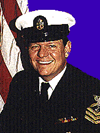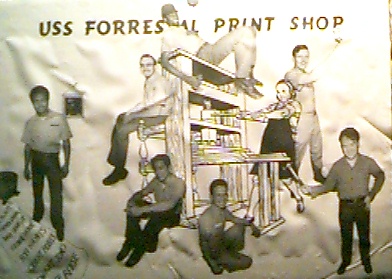

 
 
 


Submittion by NAVETSUSA Founder, Edward C. Reese (navetsusa@earthlink.net)


|
|
USS
Forrestal
|
 USA
USA
|
In the closing months of World War II, Admiral
Mark Mitscher, at the time the Commander of the Fast Carrier Task Force
in the South Pacific, made the first recorded suggestion for a carrier
with the general characteristics of the Forrestal Class. Other military
and civilian leaders agreed with him. In the years following the war, the
need for aircrait carriers larger than the Midway Class became increasingly
apparent. Advances in aviation, particularly the advent of the heavier,
faster jet aircraft, could be exploited fully only by the construction
of a large modern carrier, designed specifically for compatibility with
these high performance aircraft.
On July 12, 1951, the Navy announced that the
Newport News Shipbuilding and Dry Dock Company had been awarded a contract
to build CVA-59. The keel for the new ship was laid July 14, 1952. Less
than 30 months later, the first of the postwar carriers was launched. Mrs.
James V. Forrestal, widow of the first Secretary of Defense, christened
her USS FORRESTAL.
Commissioning ceremonies were October 1, 1955,
at the Norfolk Naval Shipyard on the same day. Captain Roy Johnson became
the first commanding officer of FORRESTAL. Commander Ralph L. Werner, commander
of the air group, recorded the first arrested landing on January 3, 1956.
Since then, FORRESTAL has recorded well over 225,000 landings.
Following a ten week shakedown cruise to Guantanamo
Bay, Cuba, and summer operations off the Atlantic coast with the US Second
Fleet, FORRESTAL was called to bolster US forces in the Mediterranean during
the Suez crisis in the fall of 1956.
The new carrier returned to Norfolk for Christmas,
but on January 23, 1957 she sailed for her first regularly scheduled deployments
as a unit of the Sixth Fleet, this time because of civil strife in Lebanon.
When the crisis ended, she returned to Norfolk.
From 1958 through 1966, FORRESTAL alternated
between the Second Fleet in the Atlantic and the US Sixth Fleet in the
Mediterranean.
In June of 1967, FORRESTAL departed Norfolk
for her first combat cruise in the Western Pacific as a member of the US
Seventh Fleet. She took up her station on Yankee Station off the coast
of North Vietnam on July 23, 1967. A tragic fire on the fifth day of combat
operations brought FORRESTAL'S part in the war to a sudden end. The fire
killed 134 men, and sent FORRESTAL back to Norfolk for repairs.
Following seven months in Norfolk Naval Shipyard,
FORRESTAL deployed for the Mediterranean in July 1968. With Air Wing Seventeen
embarked, she recorded the longest CVA deployment in the Sixth Feet up
to that time, more than nine months.
Upon returning to Norfolk in April 1969, the
ship's engineering spaces were overhauled for three months. This was followed
by six weeks refresher training at Guantanamo Bay.
On December 2nd, 1969, FORRESTAL deployed to
the Mediterranean for her eighth Sixth Fleet deployment which she completed
on July 8, 1970. Following a minor overhaul period at the shipyard, the
ship celebrated her 15th birthday by putting to sea for sea trials.
|
Following operations off the Virginia Capes area,
and a Christmas and New Year's holiday leave period, FORRESTAL left her
homeport of Norfolk for her ninth deployment with the US Sixth Fleet.
FORRESTAL returned from the Mediterranean on
July 2, 1971, and entered the shipyard in Portsmouth, Virginia, on July
16 for a ten month overhaul.
After completion of her yard period, she began
type training, carrier qualification of Attack Carrier Air Wing Seventeen
and operational readiness evaluation off the eastern coast of the US.
In the early morning of July 10, fire broke
out on the 03 level in flag country. The damage was heavy and forced FORRESTAL
into the yards again at Norfolk Naval Shipyard.
FORRESTAL left the shipyard on August 18 and
resumed preparation for her 10th deployment to the Mediterranean for which
she departed on September 22, 1972.
On March 28th, 1973, FORRESTAL sped to Tunisia
to participate in rescue operations in the flooded Medjerda River valley
near Tunis. FORRESTAL helicopters from Anti-submarine Helicopter Squadron
THREE transported thousands of pounds of food, water and medical supplies
and rescued hundreds during the three-day operation.
After returning from the Sixth Fleet on July
6, 1973, FORRESTAL entered the shipyard for a three-month overhaul. On
November 2nd, the overhaul was completed and the carrier began qualifications
of the east coast.
On March 11, 1974, FORRESTAL departed Norfolk
for the Mediterranean. During this deployment with the Sixth Fleet, operations
in the eastern Mediterranean in the vicinity of Cyprus assured a great
deal of sea time for FORRESTAL crew members.
Following her return to the US in mid-September
and a brief yard period, she steamed back into the Mediterranean in March,
1975.
Another yard period followed the return of
FORRESTAL to the US in September, keeping her in the Norfolk Naval Shipyard
until January 1976. Routine operations were conducted but excitement quickly
grew aboard her when the ship learned that the FORRESTAL was chosen to
play Host Ship at the International Naval Review in New York City Harbor
in July, 1976.
On July 4th, FORRESTAL gained national exposure
by hosting President Ford and over 100 VIPs and news media who reviewed
the arrival of the 40-odd "Tall Ships" participating in the International
Naval Review from various countries around the globe.
Another "first" was experienced by FORRESTAL
when on September 13th she was selected to undergo a Shock Test, a demolition
of high explosives near the hull to test whether a ship of capital size
could withstand the strain of full close-quarter combat and still remain
fully operational.
After the successful testing of FORRESTAL and
her crew, the ship returned to Norfolk, and on October 1, 1976 began yet
another in a long line of "firsts" an attempt to compete an extensive overhaul,
which usually takes 14 to 18 months, in only 9 months again she was successful
and steamed out of the shipyard on June 14, 1977.
On 15 June 2010, Forrestal departed Naval Station
Newport in Newport, Rhode Island, where she had been stored since 1998,
under tow for the inactive ship storage facility in Philadelphia. Forrestal
is now tied up at Pier 4 in Philadelphia, next to USS John F. Kennedy (CV-67).
It is expected Forrestal will remain there until the Navy decides her final
disposition, which will either to be sold as scrap, sunk as a target, or
scuttled as an artificial reef.
NAVETSUSA Founder, Edward C.
Reese, NCCS, USN Ret, who served on the USS Forrestal from 1975 - 1978.
Reprinted from the USS FORRESTAL Handbook (1977)

USS
Forrestal Print Shop 1977
Print
Shop Supervisor LIC Edward C. Reese
18
September 1998 ...............
Carrier
to arrive in R.I. tomorrow
The Forrestal,
more than one-fifth of a mile long, is being towed slowly from
Philadelphia
to Coddington Cove, in Middletown, where it will join the
Saratoga,
which made the same voyage last month.
By JERRY
O'BRIEN
Journal
Staff Writer
MIDDLETOWN
-- Creeping up the Atlantic coast at 5 knots, the retired Navy
aircraft
carrier Forrestal, in silent tow behind the tugboat Powhatan, is on
schedule
to arrive at Pier 1 at Coddington Cove tomorrow morning.
``It's all
proceeding according to plan,'' said David Sanders, spokesman for
the Naval
Education Training Center; the NETC property includes the deep-water
cove just
north of Newport.
``The Forrestal
should pass under the Pell Bridge at 8 a.m. and be pierside at
9:30 a.m.,''
Sanders said.
At noon
yesterday, the Forrestal was about 100 nautical miles east of Atlantic
City, N.J.,
and about 150 nautical miles from the mouth of Narragansett Bay.
In a plan
identical to that which brought the vessel's sister ship, Saratoga,
to Narragansett
Bay last month, the 1,063-foot carrier will be met -- weather
permitting
-- in the waters of Rhode Island Sound before dawn by a fleet of a
dozen tugs.
Pilots with
the Northeast Marine Pilots' Association will board the Forrestal
and coordinate
by radio the movement of the tugs through the East Passage,
under the
bridge and along the south side of Pier 1, parallel with the
Saratoga,
which is on the north side.
To ensure
the safety of boaters and the precise handling of the Forrestal, the
Coast Guard
has announced a moving safety zone one mile ahead and astern of
the carrier
and 500 yards off the vessel's sides.
The Forrestal
was commissioned in 1955 as the first Navy super carrier in a
class bearing
its name. The Saratoga, commissioned a year later, was the
second
carrier in that class.
The Forrestal
was decommissioned in 1993 and the Saratoga a year later. Since
then, both
vessels have been berthed at the Naval Inactive Ship Maintenance
Facility,
at the site of the former Philadelphia Navy Base.
The Saratoga
is eligible to be sold as scrap, but the Forrestal and a third
mothballed
vessel, the battleship Iowa, are in donation status, meaning that
they are
eligible to be purchased by nonprofit groups for preservation as
floating
museums.
The Iowa
is scheduled to arrive at Coddington Cove on Sept. 25.
The public
will be permitted to park their vehicles and watch the ship's arrival from
the apron of Pier 1, accoring to Sanders.

LinkExchange
Member
Click on the graphic
to vote for this page as a Starting Point
Hot Site.
Who We Are
How
to Join Members Page
HomePage Index
Navy
News
Naval History
Ship Locator Links
Feedback Credits
Send comments to navetsusa@earthlink.net

Last updated 18 September 1998
Founded by Edward C. Reese,
NCCS, USN Retired















